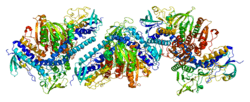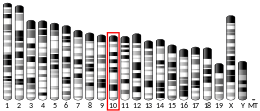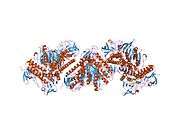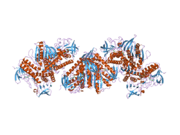TXNRD1
Thioredoxin reductase 1, cytoplasmic is an enzyme that in humans is encoded by the TXNRD1 gene.[5]
This gene encodes a member of the family of pyridine nucleotide oxidoreductases. This protein reduces thioredoxins as well as other substrates, and plays a role in selenium metabolism and protection against oxidative stress. The functional enzyme is thought to be a homodimer which uses FAD as a cofactor. Each subunit contains a selenocysteine (Sec) residue which is required for catalytic activity. The selenocysteine is encoded by the UGA codon that normally signals translation termination. The 3' UTR of selenocysteine-containing genes have a common stem-loop structure, the sec insertion sequence (SECIS), that is necessary for the recognition of UGA as a Sec codon rather than as a stop signal. Alternative splicing results in several transcript variants encoding the same or different isoforms.[6]
See also
References
- GRCh38: Ensembl release 89: ENSG00000198431 - Ensembl, May 2017
- GRCm38: Ensembl release 89: ENSMUSG00000020250 - Ensembl, May 2017
- "Human PubMed Reference:". National Center for Biotechnology Information, U.S. National Library of Medicine.
- "Mouse PubMed Reference:". National Center for Biotechnology Information, U.S. National Library of Medicine.
- Gasdaska PY, Gasdaska JR, Cochran S, Powis G (Nov 1995). "Cloning and sequencing of a human thioredoxin reductase". FEBS Lett. 373 (1): 5–9. doi:10.1016/0014-5793(95)01003-W. PMID 7589432.
- "Entrez Gene: TXNRD1 thioredoxin reductase 1".
This article incorporates text from the United States National Library of Medicine, which is in the public domain.






